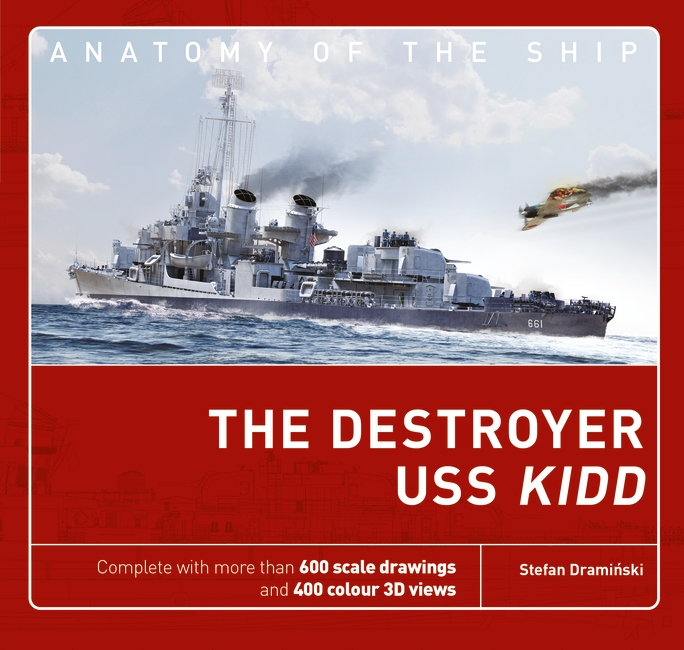
The early 1940s saw the introduction of a new destroyer class for the US Navy, which became known as the Fletcher-class. The first ships were commissioned just in time to take part in heavy combat during the Pacific War, and the excellent performance of the Fletcher-class enabled some refitted destroyers to serve in the Korean and Vietnam Wars. The total number of hulls built to the design reached an impressive figure of 175. USS Kidd (DD-661), a late square-bridged destroyer of the class, was one of the only four vessels to avoid being scrapped following active service. The ship is currently preserved as a memorial in Baton Rouge, Louisiana, and her configuration is very close to that of the late World War II period.
The museum ship's present appearance is the result of many years of restoration efforts. The goal was to bring the vessel back to her September 1945 configuration.
Early History
1942
October 16 The destroyer hull number DD-661 was laid down at the Federal Shipbuilding and Drydock Company in Kearny, New Jersey.
1943
February 28: The hull of the unfinished ship was launched. The vessel was named after Rear Admiral Isaac Kidd. During the Japanese attack on Pearl Harbor (December 7, 1941) Kidd was the commander of Battleship Division One and he was killed when his flagship USS Arizona (BB-39) received a fatal bomb hit. The late admiral’s wife, Mrs Inez Kidd, christened the destroyer during the ceremony. Three more destroyers were launched at the shipyard on the same day: USS Thorn (DD-647), USS Turner (DD-648, both Gleaves class), and USS Bullard (DD-660, Fletcher class).
April 22: Not fully equipped, USS Kidd left the builder’s shipyard to receive a final outfitting at Brooklyn Navy Yard. The young crew of the destroyer expressed their good sense of humor by choosing William Kidd, the famous 17th-century Scottish pirate, as the ship’s mascot. The Jolly Roger flag was proudly hoisted during the transfer to Brooklyn. Journalists later remarked that it was the first time in 100 years that a pirate flag was seen in New York Harbor.
April 23: Kidd was commissioned into service with the US Navy at Brooklyn Navy Yard. Commander Allan B. Roby became the destroyer’s first commanding officer.
May: Outfitting at the Brooklyn Navy Yard was completed and Kidd executed a shakedown cruise in Casco Bay, Maine. In the meantime, the crew hired an artist to paint a large pirate figure on both sides of funnel no. 1.
June: The destroyer began service with escort duties off Argentia, Newfoundland. Later in the month Kidd accompanied newly commissioned aircraft carriers during their shakedown cruises in the Caribbean.
August: Having departed Norfolk, Virginia, Kidd escorted battleships USS South Dakota (BB-57) and USS Alabama (BB-60) together with three other destroyers. The force headed towards the Panama Canal and the Pacific.
September 12: During a torpedo attack drill, two 5in illuminating shells fired from battleship USS North Carolina (BB-55) accidentally hit Kidd on the starboard side. Neither of them caused any serious damage. The first one bumped a hole in the hull just above the waterline, while the other penetrated the doctor's stateroom before being halted by a passageway’s bulkhead.
September 29: Assigned to Destroyer Division 96, Kidd departed Pearl Harbor as part of Task Force 14. Other ships involved included aircraft carriers USS Essex (CV-9), USS Yorktown (CV-10), USS Lexington (CV-16), three light carriers, six cruisers, and a number of destroyers.
October 5–6: The American force launched a series of air raids against Japanese installations on Wake Island. Apart from performing escort duties, Kidd was also involved in rescuing air crews shot down in the attack.
October 11: Having completed the mission, the destroyer returned to Pearl Harbor.
Late October: Kidd was part of the force that delivered air strikes on Japanese positions on Bougainville. American troops landed on the island on November 1.
November 11: By this date, air raids on Rabaul, New Britain, had been going on for a couple of days. Now a part of Task Group 50.3, Kidd sailed to a position south of the heavily fortified Japanese base. In the morning three carriers launched their strikes: USS Essex, USS Bunker Hill (CV-17), and USS Independence (CVL-22). One of the aircraft from Essex was forced to ditch and Kidd fell back behind the other ships to pick up the crew. The destroyer was attacked by eight Japanese dive bombers in the middle of the rescue operation. Despite the highly unfavorable conditions, Kidd’s gunners managed to shoot down three aircraft with a possible fourth and the ship escaped undamaged. Commander Roby was later awarded a Silver Star for his skillful handling of the destroyer during this action.
See more in The Destroyer USS Kidd by Stefan Draminski
Technical Specifications
|
Principal characteristics of USS Kidd (DD-661) |
|
|
Displacement |
2,050 tons (1943) – standard |
|
Length |
376ft 5in (114.8m) – overall |
|
Beam |
39ft 4in (12m) |
|
Draft |
13ft 9in (4.2m) – design |
|
Boilers |
4 x Babcock & Wilcox dual-furnace-controlled superheat boilers, working at 850°F (454°C) and 615psi (4240kPa) |
|
Turbines |
2 x General Electric geared turbine sets |
|
Maximum machinery output |
60,000shp |
|
Max speed |
37.8 knots – designed |
|
Full Capacity |
485 tonnes – fuel oil |
|
Electrical Plant |
2 x turbogenerators, 250kW AC and 40kW DC each |
|
Range |
Up to 6,500NM (12,040km) at 15 knots – designed |
|
Complement |
22 officers and 345 men (1945) |




Comments
You must be logged in to comment on this post. Click here to log in.
Submit your comment